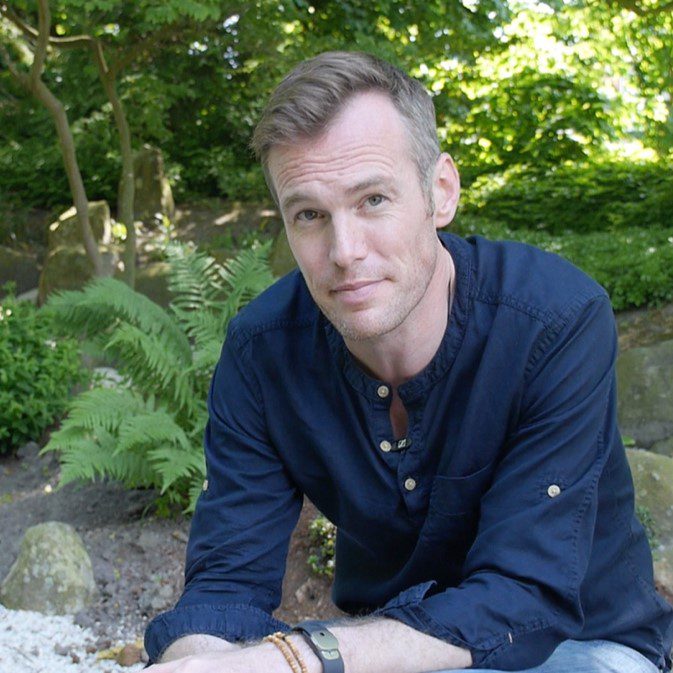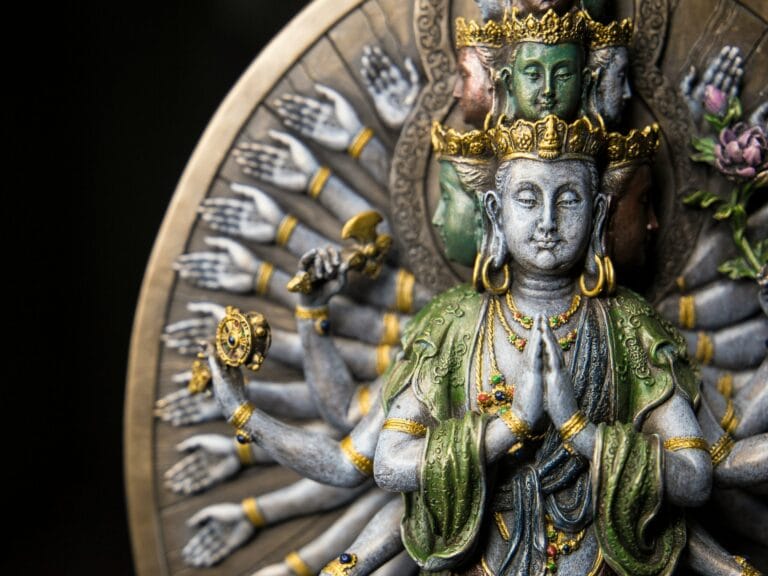Look to the trees and rocks, fields and villages, to expound dharma. Ask pillars about dharma and investigate with walls. In the past, Indra bowed to a wild fox to inquire about dharma … [and this] was not based on the fox’s high or low status of being.
The Loss of a Seagull
One night not too long ago, Natasha was out at a local lake walking with her dogs. On the drive home, she got stuck in a long line of traffic on a narrow road. Up ahead, there was some kind of construction taking place. When she finally got to the front of the line, she could see the workers with their equipment breaking up the road to get to a pipe. Night was falling. Rain was falling. They were toiling. And then, as she waited for the traffic light to change to green, her eyes fell on two seagulls by the side of the road. They had clearly been hit by a car. One of them was already dead. The other was struggling and shrieking and panicking and dying right there on the verge, while everyone sat in their cars and ignored it, impatient to get home, and while the workers toiled in their hole just a few meters away.
Natasha followed the line of traffic and drove home but couldn’t get the image of that Seagull out of her head. She couldn’t un-see it. Couldn’t un-feel it. In an effort to do something to help, she called Animal Control and told them about it. Animal Control told her to call someone else, who told her to call someone else. Eventually, she spoke with a volunteer organization that wanted to help, but they had no volunteers available. They asked her whether she could return, collect the bird, and bring it to them. She told them that she didn’t have the stomach for it, that the horror of it was too much, that she couldn’t go back there.
Samvega is a form of horror that is spiritually galvanizing rather than petrifying; rather than causing us to plunge our heads into the sand like an ostrich, it makes us lift them towards the sky with integrity and vulnerability.
A few minutes after she’d hung up the phone, sitting with guilt, shame, and empathic suffering, Natasha found compassionate courage arising in her heart. She ran to get some towels and a box, jumped in the car, and, crying the whole time, drove back to the construction site. Once she arrived, she saw that the second Seagull had already died. Someone had scattered wildflowers over the two corpses.
Recognizing a Teacher
How do we know when we’ve encountered a good teacher? It rarely has much to do with their formal qualifications, the letters after their name, or the prestige of the institution where they teach. It’s got little to do with whether their jacket is tweed or pleather. If I asked you to tell me about your favourite teacher, what would you say?
In his masterwork, the Shōbōgenzō, the thirteenth-century Japanese monk Dōgen, founder of Sōtō Zen Buddhism, advised us not to judge teachers by their appearance or even their manners. We should ignore issues of race and gender and heredity. We should not fixate on the things we dislike about them since such fixation just gets in our own way. Instead, we should simply value whatever wisdom we can receive from our teachers and “sprinkle them with celestial flowers” in gratitude. For Dōgen, finding a good teacher is a kind of practice in itself, requiring us to pay attention to all beings with reverence and respect. The responsibility is ours, not theirs. Encountering a good teacher entreats us to be open to learning from them, whosoever or whatsoever they might be. If we are not open to learning, the encounter just doesn’t happen. If we are open, then perhaps anyone or anything can be a good teacher?
The passage quoted at the top of this essay is typical of Dōgen’s view: even rocks, trees, fields, and foxes can teach us the dharma if only we find a way to ask them and hear them. “Dharma” is the word we use to label the teachings of the Buddha and the truths about the world to which they guide us.

In recent years, I’ve been fortunate to encounter several good teachers. One dear to me was a tiny, uprooted Maple-seedling that I found discarded on a forest trail near my home. Someone had wrenched it out of the ground and discarded it. Most of its roots had been torn away, and it lay there, right at the base of a towering mother-tree, utterly detached and alone; its scarce, tiny leaves were already beginning to shrivel and die. Surely I had walked past thousands of such scenes in the past without allowing them in, without even noticing them. But something about that seedling on that path on that day arrested me. Perhaps it was the weight of the raindrops or the rich fecundity of the petrichor just then? Perhaps it was the way the fading orange light of dusk touched those tiny, dying leaves with such exquisite gentleness? Whatever it was, I felt my heart break right then and there on the path. Sadly, I didn’t have any celestial flowers with me, but I scattered them in my mind.
I learned from that encounter with an unexpected teacher on the path that I am not other than the suffering of a discarded seedling. If I look to this little tree to expound the dharma, what does it teach me? It teaches me that if I allow it—if I don’t pass by in ignorance, if I don’t turn away in denial—even a little seedling can evoke and manifest my interdependence and interbeing. If I let it, that little seedling can cause compassion to arise in me. The suffering of this tiny treelet offers me a whole world, and not only one of openness to more loss; the following spring, after I’d taken it home and nurtured it, the seedling’s aspiring green profusion of leaves gave me the gift of sympathetic joy. Has this once-broken treeling really taught me how to thrill at the flight of a bald eagle, to laugh at the abrupt, erratic energy of the squirrels, and to cry at the confused anguish in the eyes of a fawn whose mother has just been hit by a car?
Transform Everything into the Path
At about the same time that Dōgen was investigating with the trees and rocks in Japan, the Kadampa Buddhist master in Tibet, Chekawa Yeshé Dorjé (1101-1175), was formulating the Lojong teachings, “Seven-Point Mind Training.” Lojong focuses on the practitioner’s development of compassion as a response to all adverse conditions, suffering, and loss. Perhaps the most famous of these points is the third, which begins with these lines: When the environment and its inhabitants are enslaved by evil, transform unfavorable circumstances into the path of awakening.
One of the key lessons I have learned from Lojong is that compassion arises only when we notice the suffering around us, only when we don’t turn away or drive past. It is said, for instance, that Yeshé Dorjé formulated the Seven Points following frequent encounters with people suffering from leprosy, which was then incurable. This seems to echo the story of Siddhartha Gautama’s three encounters, with a sick person, an aging person, and a corpse, which broke him open to the suffering of the world and occasioned him to renounce his kingdom and set off on the path to become the Buddha in order to end the suffering of all beings.
These kinds of encounters are known as samvega in early Buddhism (in Pali and Sanskrit). Samvega captures a sense of shock, dismay, and grief that breaks us out of our comfortable little enclaves, out of our complacencies, and calls us into a transformed way of life. Samvega literally breaks the world open to our gaze through the force of looking straight at the sun, opening ourselves to the suffering and loss that is all around and within us. Do not turn away! Samvega is a form of horror that is spiritually galvanizing rather than petrifying; rather than causing us to plunge our heads into the sand like an ostrich, it makes us lift them towards the sky with integrity and vulnerability. It promises us clarity of insight but requires us to be unflinching about what we find. It takes strength and courage.
We must not deny the suffering of anything; rather, we must come alongside that suffering and allow the loss to break our hearts. We must not turn away.
For me, there is some resonance between Dōgen’s recognition that we can encounter anything as a teacher if we approach it with a respectful mind that is open to learning and Yeshé Dorjé’s teaching that any experience, any encounter, no matter how adverse, can support our cultivation of compassion and become a step on our pathway towards liberation. In both cases, the onus is on us, all the time, to encounter the world with acceptance, compassion, and respect. We must not deny the suffering of anything; rather, we must come alongside that suffering and allow the loss to break our hearts. We must not turn away.
How might it have been had Siddhartha been broken open by an uprooted tree or the death of a seagull instead of a sick, aged, and then dead human?
How a Dead Seagull Can Change the World
On the night after her encounter with the Seagull, Natasha slept fitfully. Her mind couldn’t let go of the suffering of that Seagull and the ache of loss she felt in her heart. In the morning, tired and distraught, through her tears, she expressed overwhelming empathic distress, but also some embarrassment about the intensity of her reaction: “Who cries over a Seagull!? It’s crazy. I’m just being weak and pathetic, aren’t I?”
But was Natasha weak? Were the strong people those who drove past the dead and dying birds without noticing them, their minds already immersed in the glass of wine awaiting them at home, or lost in a haze of resentment about a disagreement at work earlier that day? Or perhaps the strong ones were those who did notice the suffering and the loss but then quickly turned away, checked their phone or changed the channel on the radio?
And was Natasha crazy? Well, I doubt Chekawa Yeshé Dorjé would think so. He would likely commend her for manifesting the courage to allow this suffering into her heart, and for responding to that pain with love and compassion. Natasha had allowed this encounter with dead and dying Seagulls to crack open her world, making a space to let in the light. This feels like samvega. And it seems to me that Dōgen wouldn’t think Natasha was crazy. He would likely admire her, as he admired Indra for seeking teaching from a fox, as he admired those who looked to the trees and the rocks for dharma. He cast as foolish those who refused to recognise a teacher or teaching just because it was encountered in an unexpected or inauspicious place. “Ask pillars about dharma and investigate with walls.”
This article was originally published at Center for Humans & Nature. It is reprinted here with permission.








